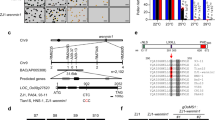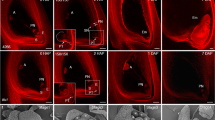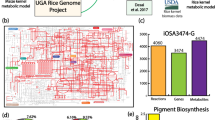Abstract
Hybrid rice, widely planted in Asia, is pathogen resistant and has superior yields, making it a major contributor to global food security. The two-line hybrid rice system, which utilizes mutants exhibiting photo-/thermo-sensitive genic male sterility (P/TGMS), is the leading hybrid rice breeding technology. Mutations in THERMO-SENSITIVE GENIC MALE STERILE 5 (TMS5) accounts for over 95% of current TGMS lines. We previously found that tms5 carries a mutation in ribonuclease ZS1. Despite its importance for breeding robust rice lines, the mechanism underlying tms5-mediated TGMS remains elusive. Here, we demonstrate that TMS5 is a tRNA 2′,3′-cyclic phosphatase. The tms5 mutation leads to accumulation of 2′,3′-cyclic phosphate (cP)-ΔCCA-tRNAs (tRNAs without 3′ CCA ended with cP), which is exacerbated by high temperatures, and reduction in the abundance of mature tRNAs, particularly alanine tRNAs (tRNA-Alas). Overexpression of tRNA-Alas in the tms5 mutant restores male fertility to 70%. Remarkably, male fertility of tms5 mutant is completely restored at high temperatures by knocking out OsVms1 which encodes the enzyme for cP-ΔCCA-tRNA generation. Our study reveals the mechanism underlying tms5-mediated TGMS in rice and provides mechanistic insight into the further improvement of TGMS in hybrid crop development.
This is a preview of subscription content, access via your institution
Access options
Subscribe to this journal
Receive 12 digital issues and online access to articles
$119.00 per year
only $9.92 per issue
Buy this article
- Purchase on SpringerLink
- Instant access to full article PDF
Prices may be subject to local taxes which are calculated during checkout






Similar content being viewed by others
Data availability
The RcP-RNA-seq and FINE-tRNA-seq data have been deposited in the Genome Sequence Archive in National Genomics Data Center, China National Center for Bioinformation/Beijing Institute of Genomics, Chinese Academy of Sciences (https://ngdc.cncb.ac.cn/gsa/) with the accession number: CRA014058. Crystal structure information of rice TMS5 has been deposited in the PDB (https://www.rcsb.org/) with ID 7XGT. All other data are available in the manuscript or the supplementary information.
References
Tester, M. & Langridge, P. Breeding technologies to increase crop production in a changing world. Science 327, 818–822 (2010).
Qian, Q., Zhang, F. & Xin, Y. Yuan longping and hybrid rice research. Rice 14, 101 (2021).
Normile, D. Crossing rice strains to keep Asia’s rice bowls brimming. Science 283, 313–313 (1999).
Jones, J. W. Hybrid vigor in rice1. Agron. J. 18, 423–428 (1926).
He, Q. et al. Hybrid Rice. Engineering 6, 967–973 (2020).
Fan, Y. & Zhang, Q. Genetic and molecular characterization of photoperiod and thermo-sensitive male sterility in rice. Plant Reprod. 31, 3–14 (2018).
Yu, J. et al. Two rice receptor-like kinases maintain male fertility under changing temperatures. Proc. Natl. Acad. Sci. USA 114, 12327–12332 (2017).
Chen, R. et al. Rice UDP-glucose pyrophosphorylase1 is essential for pollen callose deposition and its cosuppression results in a new type of thermosensitive genic male sterility. Plant Cell 19, 847–861 (2007).
Wu, L. et al. A natural allele of OsMS1 responds to temperature changes and confers thermosensitive genic male sterility. Nat. Commun. 13, 2055 (2022).
Zhou, H. et al. Photoperiod- and thermo-sensitive genic male sterility in rice are caused by a point mutation in a novel noncoding RNA that produces a small RNA. Cell Res. 22, 649–660 (2012).
Ding, J. et al. A long noncoding RNA regulates photoperiod-sensitive male sterility, an essential component of hybrid rice. Proc. Natl. Acad. Sci. USA 109, 2654–2659 (2012).
Teng, C. et al. Dicer-like 5 deficiency confers temperature-sensitive male sterility in maize. Nat. Commun. 11, 2912 (2020).
Zhu, J. et al. Slowing development restores the fertility of thermo-sensitive male-sterile plant lines. Nat. Plants 6, 360–367 (2020).
Shi, Q. S. et al. A cellular mechanism underlying the restoration of thermo/photoperiod-sensitive genic male sterility. Mol. Plant 14, 2104–2114 (2021).
Peng, G. et al. The E3 ubiquitin ligase CSIT1 regulates critical sterility-inducing temperature by ribosome-associated quality control to safeguard two-line hybrid breeding in rice. Mol. Plant 16, 1695–1709 (2023).
Zhou, H. et al. RNase Z(S1) processes UbL40 mRNAs and controls thermosensitive genic male sterility in rice. Nat. Commun. 5, 4884 (2014).
Liu, W. et al. Reproductive tissue-specific translatome of a rice thermo-sensitive genic male sterile line. J. Genet. Genomics 49, 624–635 (2022).
Li, J. et al. Generation of thermosensitive male-sterile maize by targeted knockout of the ZmTMS5 gene. J. Genet. Genomics 44, 465–468 (2017).
Yip, M. C. J., Savickas, S., Gygi, S. P. & Shao, S. ELAC1 repairs tRNAs cleaved during ribosome-associated quality control. Cell Rep. 30, 2106–2114 (2020).
Pinto, P. H. et al. ANGEL2 is a member of the CCR4 family of deadenylases with 2’,3’-cyclic phosphatase activity. Science 369, 524–530 (2020).
Yip, M. C. J. et al. Mechanism for recycling tRNAs on stalled ribosomes. Nat. Struct. Mol. Biol. 26, 343–349 (2019).
Li de la Sierra-Gallay, I., Mathy, N., Pellegrini, O. & Condon, C. Structure of the ubiquitous 3’ processing enzyme RNase Z bound to transfer RNA. Nat. Struct. Mol. Biol. 13, 376–377 (2006).
Kostelecky, B., Pohl, E., Vogel, A., Schilling, O. & Meyer-Klaucke, W. The crystal structure of the zinc phosphodiesterase from Escherichia coli provides insight into function and cooperativity of tRNase Z-family proteins. J. Bacteriol. 188, 1607–1614 (2006).
Ishii, R. et al. Crystal structure of the tRNA 3’ processing endoribonuclease tRNase Z from Thermotoga maritima. J. Biol. Chem. 280, 14138–14144 (2005).
Li de la Sierra-Gallay, I., Pellegrini, O. & Condon, C. Structural basis for substrate binding, cleavage and allostery in the tRNA maturase RNase Z. Nature 433, 657–661 (2005).
Gu, H. et al. A 5’ tRNA-Ala-derived small RNA regulates anti-fungal defense in plants. Sci. China Life Sci. 65, 1–15 (2022).
Tanaka, N., Meineke, B. & Shuman, S. RtcB, a novel RNA ligase, can catalyze tRNA splicing and HAC1 mRNA splicing in vivo. J. Biol. Chem. 286, 30253–30257 (2011).
Behrens, A., Rodschinka, G. & Nedialkova, D. D. High-resolution quantitative profiling of tRNA abundance and modification status in eukaryotes by mim-tRNAseq. Mol. Cell 81, 1802–1815 (2021).
Sakata, T. & Higashitani, A. Male sterility accompanied with abnormal anther development in plants – genes and environmental stresses with special reference to high temperature injury. Int. J. Plant Dev. Biol. 2, 42–51 (2008).
Dimitrova, L. N., Kuroha, K., Tatematsu, T. & Inada, T. Nascent peptide-dependent translation arrest leads to Not4p-mediated protein degradation by the proteasome. J. Biol. Chem. 284, 10343–10352 (2009).
Letzring, D. P., Wolf, A. S., Brule, C. E. & Grayhack, E. J. Translation of CGA codon repeats in yeast involves quality control components and ribosomal protein L1. RNA 19, 1208–1217 (2013).
Gamble, C. E., Brule, C. E., Dean, K. M., Fields, S. & Grayhack, E. J. Adjacent codons act in concert to modulate translation efficiency in yeast. Cell 166, 679–690 (2016).
Simms, C. L., Hudson, B. H., Mosior, J. W., Rangwala, A. S. & Zaher, H. S. An active role for the ribosome in determining the fate of oxidized mRNA. Cell Rep. 9, 1256–1264 (2014).
Doma, M. K. & Parker, R. Endonucleolytic cleavage of eukaryotic mRNAs with stalls in translation elongation. Nature 440, 561–564 (2006).
Shen, P. S. et al. Protein synthesis. Rqc2p and 60S ribosomal subunits mediate mRNA-independent elongation of nascent chains. Science 347, 75–78 (2015).
Choe, Y. J. et al. Failure of RQC machinery causes protein aggregation and proteotoxic stress. Nature 531, 191–195 (2016).
Yonashiro, R. et al. The Rqc2/Tae2 subunit of the ribosome-associated quality control (RQC) complex marks ribosome-stalled nascent polypeptide chains for aggregation. ELife 5, e11794 (2016).
Lei, D., Tang, W., Xie, Z., Liu, H. & Chen, L. Solutions to insecurity problems in seed production of two-line hybrid rice. Agric. Sci. Technol. 15, 1160–1166 (2014).
Ma, X. et al. A Robust CRISPR/Cas9 system for convenient, high-efficiency multiplex genome editing in monocot and dicot plants. Mol. plant 8, 1274–1284 (2015).
Kabsch, W. XDS. Acta Crystallogr. Sect. D Biol. Crystallogr. 66, 125–132 (2010).
Adams, P. D. et al. PHENIX: a comprehensive Python-based system for macromolecular structure solution. Acta Crystallogr. Sect. D Biol. Crystallogr. 66, 213–221 (2010).
Emsley, P., Lohkamp, B., Scott, W. G. & Cowtan, K. Features and development of Coot. Acta Crystallogr. Sect. D Biol. Crystallogr. 66, 486–501 (2010).
Chen, V. B. et al. MolProbity: all-atom structure validation for macromolecular crystallography. Acta Crystallogr. Sect. D Biol. Crystallogr. 66, 12–21 (2010).
Li, X. et al. Base-resolution mapping reveals distinct m(1)A methylome in nuclear- and mitochondrial-encoded transcripts. Mol. Cell 68, 993–1005 (2017).
Martin, M. CUTADAPT removes adapter sequences from high-throughput sequencing reads. EMBnet J. 17, 10–12 (2011).
Langmead, B. & Salzberg, S. L. Fast gapped-read alignment with Bowtie 2. Nat. Methods 9, 357–359 (2012).
Acknowledgements
We thank Dr. Bo Cao at Shanghai Jiao Tong University, Dr. Chengqi Yi and Dr. Xiaoyu Li at Peking University for helping in constructing tRNA-seq library, and Dr. Xuan Ma at Tianjin Normal University for his assistance with previous bioinformatics analyses. We particularly thank Dr. Falong Lu at the Institute of Genetics & Developmental Biology, CAS and Dr. Yusheng Liu at the Northeast Forestry University for discussing and revising the manuscript. We also thank Mr. Zhenhua Guo at the Institute of Genetics and Developmental Biology, CAS, and Dr. Guocheng Hu at China National Rice Research Institute for rice cultivation. This work was supported by grants from the Biological Breeding-National Science and Technology Major Project of China (2023ZD04073), the National Key R&D Program of China (2020YFA0509900), the National Natural Science Foundation of China (32330019, 32171284, 32170620 and 32370633), the Strategic Priority Research Program of Chinese Academy of Sciences (XDA24010302).
Author information
Authors and Affiliations
Contributions
X.C., Y.C., Y.Y., C.L., and B.Y. conceived and planned the experiments. B.Y., C.L., Y.M., C.Z., J.L., W.L., S.L., W.Y., C.F., P.Q., X.F., X.Z., X.S., J.N., and F.G. performed and analyzed the experiments. J.S. worked on bioinformatics analysis. B.Y., C.L., J.S., Y.Y., Y.C., and X.C. interpreted the results and wrote the manuscript.
Corresponding authors
Ethics declarations
Competing interests
The authors declare no competing interests.
Rights and permissions
Springer Nature or its licensor (e.g. a society or other partner) holds exclusive rights to this article under a publishing agreement with the author(s) or other rightsholder(s); author self-archiving of the accepted manuscript version of this article is solely governed by the terms of such publishing agreement and applicable law.
About this article
Cite this article
Yan, B., Liu, C., Sun, J. et al. Impaired 2′,3′-cyclic phosphate tRNA repair causes thermo-sensitive genic male sterility in rice. Cell Res 34, 763–775 (2024). https://doi.org/10.1038/s41422-024-01012-4
Received:
Accepted:
Published:
Issue date:
DOI: https://doi.org/10.1038/s41422-024-01012-4
This article is cited by
-
The OsRqc1-OsVms1 module regulates the temperature threshold in thermo-sensitive genic male-sterile rice lines
Science China Life Sciences (2025)
-
tRNA repair: the key to thermo-sensitive male sterility in rice
Cell Research (2024)



